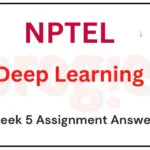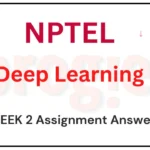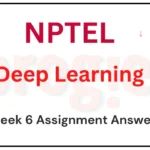Deep Learning | Week 2
Course Name: Deep Learning
Course Link: Click Here
These are NPTEL Deep Learning Week 2 Assignment 2 Answers
Q1. Suppose if you are solving a four class problem, how many discriminant function you will need for solving?
a. 1
b. 2
c. 3
d. 4
Answer: d. 4
Q2. Two random variable X1 and X2 follows Gaussian distribution with following mean and covariance.
X1~N (0, 3) and X2~N (0, 2).
Which of following will is true.
a. Distribution of X1 will be more flat than the distribution of X2.
b. Distribution of X2 will be more flat than the distribution of X1.
c. Peak of the both distribution will be same
d. None of above.
Answer: a. Distribution of X1 will be more flat than the distribution of X2.
These are NPTEL Deep Learning Week 2 Assignment 2 Answers
Q3. Which of the following is true with respect to the discriminant function for normal density.\?
a. Decision surface is always orthogonal bisector to two surfaces when the covariance matrices of different classes are identical but otherwise arbitrary
b. Decision surface is generally not orthogonal to two surfaces when the covariance matrices of different classes are identical but otherwise arbitrary
c. Decision surface is always orthogonal to two surfaces but not bisector when the covariance matrices of different classes are identical but otherwise arbitrary
d. Decision surface is arbitrary when the covariance matrices of different classes are identical but otherwise arbitrary
Answer: b. Decision surface is generally not orthogonal to two surfaces when the covariance matrices of different classes are identical but otherwise arbitrary
Q4. In which of following case the decision surface intersect the line joining two means of two class at midpoint? (Consider class variance is large relative to the difference of two means)
a. When both the covariance matrices are identical and diagonal matrix.
b. When the covariance matrices for both the class are identical but otherwise arbitrary.
c. When both the covariance matrices are identical and diagonal matrix, and both the class has equal class probability.
d. When the covariance matrices for both class are arbitrary and different.
Answer: c. When both the covariance matrices are identical and diagonal matrix, and both the class has equal class probability.
These are NPTEL Deep Learning Week 2 Assignment 2 Answers
Q5. The decision surface between two normally distributed class w₁ and w2 is shown on the figure. Can you comment which of the following is true?

a. Σi = 621, where Σi is covariance matrix of class i
b. Σi = Σ, where Σ₁ is covariance matrix of class i
c. Σi = arbitary, where Σi is covariance matrix of class i
d. None of the above.
Answer: c. Σi = arbitary, where Σi is covariance matrix of class i
Q6. For minimum distance classifier which of the following must be satisfied?
a. All the classes should have identical covariance matrix and diagonal matrix.
b. All the classes should have identical covariance matrix but otherwise arbitrary.
c. All the classes should have equal class probability.
d. None of above.
Answer: c. All the classes should have equal class probability.
These are NPTEL Deep Learning Week 2 Assignment 2 Answers
Q7. You found your designed software for detecting spam mails has achieved an accuracy of 99%, i.e., it can detect 99% of the spam emails, and the false positive (a non-spam email detected as spam) probability turned out to be 5%. It is known that 50% of mails are spam mails. Now if an email is detected as spam, then what is the probability that it is in fact a non-spam email?
a. 5/104
b. 5/100
c. 4.9/100
d. 0.25/100
Answer: a. 5/104
These are NPTEL Deep Learning Week 2 Assignment 2 Answers
Q8. Which of the following statements are true with respect to K-NN classifier?
1. In case of very large value of k, we may include points from other classes into the neighbourhood.
2. In case of too small value of k the algorithm is very sensitive to noise.
3. KNN classifier classify unknown samples by assigning the label which is most frequent among the k nearest training samples.
a. Statement 1 only
b. Statement 1 and 2 only
c. Statement 1, 2, and 3
d. Statement 1 and 3 only
Answer: c. Statement 1, 2, and 3
These are NPTEL Deep Learning Week 2 Assignment 2 Answers
Q9. You have given the following 2 statements, find which of these option is/are true in case of k NN?
4. In case of very large value of k, we may include points from other classes into the neighbourhood.
5. In case of too small value of k the algorithm is very sensitive to noise.
a. 1
b. 2
c. 1 and 2
d. None of this.
Answer: c. 1 and 2
These are NPTEL Deep Learning Week 2 Assignment 2 Answers
Q10. The decision boundary of linear classifier is given by the following equation.
4x₁ + 6x₂ – 11 = 0
What will be class of the following two unknown input example? (Consider class 1 as positive class, and class 2 as the negative class)
a2= [1, 2]
a2= [1,1]
a. a1 belongs to class 1, a2 belongs to class 2
b. a2 belongs to class 1, a1 belongs to class 2 belongs to class 2
c. a1 belongs to class 2, a2 belongs to class 2
d. a1 belongs to class 1, a2 belongs to class 1
Answer: a. a1 belongs to class 1, a2 belongs to class 2
These are NPTEL Deep Learning Week 2 Assignment 2 Answers
These are NPTEL Deep Learning Week 2 Assignment 2 Answers
More weeks of Deep Learning: Click Here
More Nptel Courses: https://progiez.com/nptel









